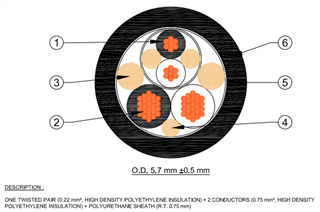Hi!
I'm exploring the TDR function on the DP83TD510E. I've made measurements up to 625m, but beyond that I cannot get a result. In snla364c pg.6 there is a note:
Note A High Attenuation cable might need a different TDR script. A Register 030C reading of 0000 indicates that the cable is a high attenuation cable.
What do I need to change to make the script work with longer cables or higher attenuation? I'm using the default script from snla364c revision C. Knowing a little more about the TDR-registers would also be helpful (0x300-0x30A and 0x30E-0x310)
The cable is a single twisted pair with a ~100Ohm characteristic impedance, 0.22mm^2/24AWG area.
At 625m I get the following results (open ended cable):
DP83TD510E_TDR_Status.txt file is open...
Register 001F is: 4000
Register 001E is: 0002
Register 030C is: 0EBC
Register 0305 is: 0038
Register 0306 is: 0000
Register 0307 is: 1500
Register 0308 is: 0000
Register 0309 is: 0000
Register 030A is: 0001
End of file.
Which tells me:
| dec | ||
| TDR_CFG | TDR_Done | 1 |
| TDR_Fail | 0 | |
| TDR_Fault_Status | Peak_Detect | 1 |
| Peak_Sign | 1 | |
| Peak_Location | 700 | |
| FAULT_STAT1 | peaks_loc_1 | |
| peaks_loc_0 | 56 | |
| FAULT_STAT3 | peaks_amp_0 | 21 |
| peaks_loc_4 | 1 |
At 815m I get the following results (open ended cable):
DP83TD510E_TDR_Status.txt file is open...
Register 001F is: 4000
Register 001E is: 0002
Register 030C is: 0000
Register 0305 is: 0000
Register 0306 is: 0000
Register 0307 is: 0000
Register 0308 is: 0000
Register 0309 is: 0000
Register 030A is: 0000
End of file.
Which tells me the TDR-process has run successfully, but no return signal detected?
Regards,
Johan Kleiberg Jensen.



